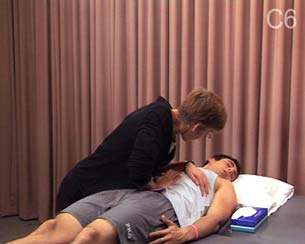AIM:
To perform an assisted cough for a person with complete C6 tetraplegia.
Rationale:
An assisted cough is used to help people with spinal cord injury clear secretions. The therapist uses his/her hands to apply a sudden and forceful overpressure to the chest or abdominal wall as the patient attempts to cough. The overpressure substitutes for paralysis of the intercostal and abdominal muscles.
Equipment:
- Height-adjustable bed
- Tissues
- Suctioning equipment (not shown in video clip)
Key Points:
- The top arm is positioned across the chest. Pressure is applied in a downward and latero-medial direction
- The heel of the bottom hand is positioned over the epigastic area, below xiphoid process. Pressure is applied in a downward and superior direction
- Ensure that the overpressure is timed with the patient’s attempt at coughing
- Ensure that the overpressure is applied quickly and forcefully
- Ensure that therapist uses his/her body weight and position rather than upper limb strength to attain sufficient force
Common Errors:
- The bed is positioned too high
- Therapist applies overpressure which is too strong or too weak
- Therapist fails to remind patient to turn head away (provided this in not medically contra-indicated)
- The overpressure is not timed with the patient’s attempts at coughing
- The neck of recently-injured patients with tetraplegia is not adequately stabilized
- Assisted coughs are performed when medically contra-indicated
Progression and Variety:
- Mechanically inflate the lungs prior to coughing to maximize initial lung volume
- Administer nebulised saline prior to treatment to help loosen secretions
- Use an in-exsufflator to enhance the effectiveness of the assisted cough
- A number of different strategies may be used with one, two and three therapists assisting
